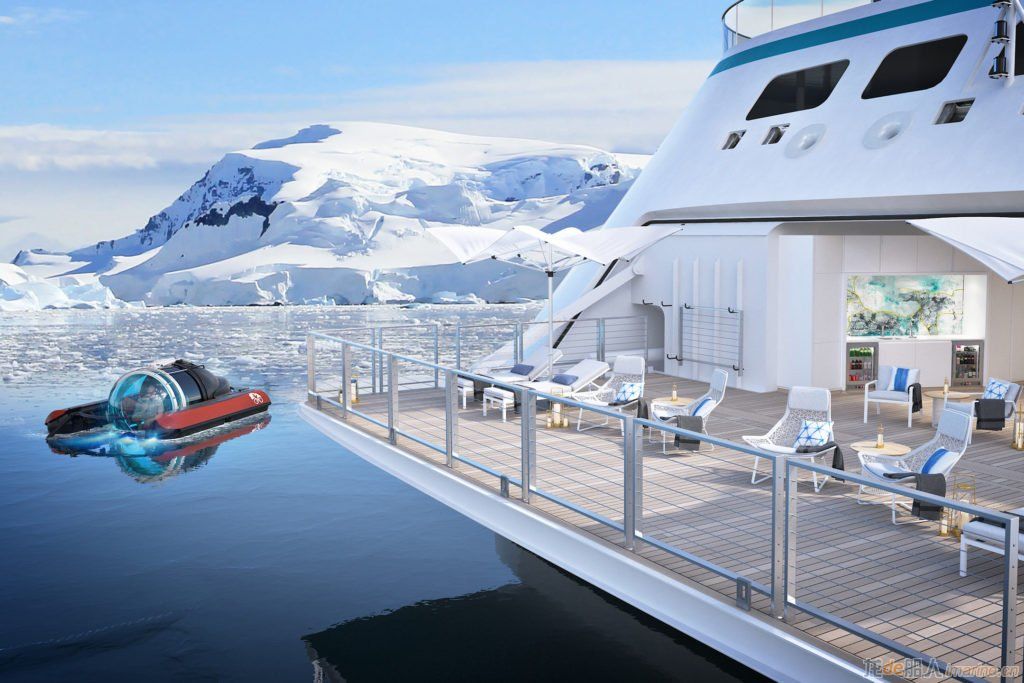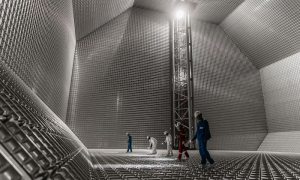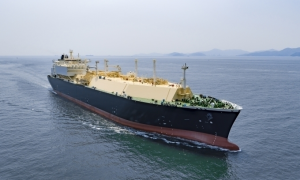當郵輪船東需要能夠作為技術合作伙伴的供應商來參與早期設計的關鍵時刻,麥基嘉在郵輪業務上所具備的整合能力就是一種優勢,麥基嘉郵輪業務發展經理Mats Olsson指出。

據最新預測顯示,全球大型郵輪手持訂單總計120艘,價值650億歐元,而探險郵輪需求的激增也推升了長度低于200米的郵輪手持訂單量超過40艘,可見,這一專業市場的技術合作伙伴前景光明。
麥基嘉于2019年收購了TTS集團的船舶與海工業務,之后積極整合了雙方的郵輪業務。隨著新造“巨型”郵輪越來越朝著大型化發展,以及新一代探險郵輪的出現,這兩家公司一直都在為漫長的建造熱潮服務。麥基嘉參與了56艘郵輪,其中23艘在建;而TTS的項目清單中有60艘郵輪, 包括15艘在建新船。
麥基嘉在郵輪領域的產品能力已經擴展到舷門、平臺、系泊系統、起重機和絞車等,整合后其產品組合得以進一步擴展,增加了舷梯,并擴展了舷門和平臺的產品組合。麥基嘉還借此機會提升了按船廠排期交付標準設備的能力,同時加強了公司全天候全球服務支持能力。
同樣重要的是,大型郵輪規模擴大,探險郵輪設計趨于多樣化,為了幫助船東實現雄心壯志,對船舶設備的創新提出了更高的要求。麥基嘉正加速轉型成為一家整體解決方案提供商,可以按照船東的愿景設計出在現實中可落地的貨物和負載處理系統,相信麥基嘉和TTS整合后將成為真正的定位于為客戶增加價值的技術合作伙伴,從郵輪設計初期階段就開始合作。
在巨型郵輪上,以前從未考慮過在海上部署的“驚喜”景觀設施必須基于適用于遠洋航行結構的設計和工程原理。其中一個引人注目的案例是“Celebrity Edge”號郵輪右舷的“魔毯”,這是一個與船廠合作構思的項目。這個有座位、酒吧和現場音樂空間的平臺長110英尺,寬20英尺,可以升高至頂層甲板之上,變身為特色餐廳“Dinner on the Edge”,與第14層甲板的主泳池上下呼應。它也可以下降至第5層甲板,從而擴展第5層甲板的餐廳,或者下降至第2層甲板成為豪華登乘點。我們可以看到該設備供應商的角色可以追溯到該船交付前兩年,與船舶設計公司及船廠密切合作,實現設計范圍內的最佳效果。
麥基嘉麥在2015年為首艘量子級郵輪開發“北極星(North Star)”觀景臺時采取了類同的方式。一臺起重機和座艙可以將14名游客提升至海平面上方91米高處,將郵輪、大海和停靠港美景盡收眼底。在這個項目中,早期參與確保了使用成熟技術以實現壯觀的交付,包括100%的動力裝置冗余和柴油機應急動力站、自動切斷和安全閥過載保護,以及為乘坐舒適性設計的控制擺動的穩定系統。
如果說麥基嘉在項目早期參與郵輪設計過程還不是一種常態,那肯定是一種趨勢,顯然適用于探險郵輪,因為它屬于“巨型”郵輪市場。
再來看另一個典型案例,麥基嘉與一家大型郵輪公司合作為其系列探險郵輪開發一種折疊式平臺,進行了頭腦風暴。從乘客的角度來看,這是一個可以真正沉浸于北極奇觀中的機會。對于工程師來說,需要的是一個可折疊、帶翼的精密平臺,該平臺可以延伸至船舶以外3米處,成為一個觀景陽臺,并且后方留有舷梯系統的空間。
對于巨型郵輪和探險郵輪,麥基嘉也在與船東和船舶設計公司越來越緊密地合作,對登船、貨物和補給流程進行優化。對于巨型郵輪,模擬軟件有助于對人群有時不可預測的行為進行建模,例如,優化物流方案使流通點不會成為擁堵點。在最近的一個案例中,模擬軟件的使用建議將乘客安檢點的數量翻倍。
隨著新一代郵輪駛向新的目的地,對技術合作伙伴的需求將在設計項目早期就同時涉及到硬件和軟件。極地船舶必須能夠在高度規范的環境中達到安全和可持續性要求,譬如,這會影響對水密門及其材料和機械方案的選擇。
最新的參考項目包括系列探險郵輪上為直升機配備的防風雨、加固機庫門,以及用于潛水器的艙門。還有為超豪華PC6等級探險郵輪提供的水密門。麥基嘉推出了自己“生態”潤滑油系列,但也一直專注于全電動舷門,出于聲譽原因,到北極原始水域游覽的客人對液壓油泄漏持零容忍的態度。
與液壓操作的同類產品相比,全電動舷門的安裝成本較低,在作業時噪音也較小。事實上,全電動選項在郵輪業的其他領域正在逐漸普及,在這些領域中,環保措施勢在必行。其中,阿依達郵輪和歌詩達郵輪公司的LNG動力船堪稱典范。值得一提的是,麥基嘉已經開發出一種用于LNG燃料加注站的特殊電動舷門,其設計已獲船級社批準。
在乘客通道方面,早期參與設計過程也表明,麥基嘉將越來越多地被視為技術合作伙伴,而不僅僅是設備供應商。其中一個案例是研發內部伸縮式乘客舷梯的開創性工作。這種舷梯可上下移動15度,以適應5至6米的潮汐范圍,例如途易郵輪公司Mein-Schiff系列郵輪上看到的那些,以及“跟隨碼頭”的側載系統,在該系統中可以通過升降憑條以對齊登船。
總而言之,可以公平地說,當船東在考慮一艘新郵輪的所有要求時,麥基嘉可能還不是他們最先想到的。但可以說,船東越來越認識到,他們的技術合作伙伴可以幫助他們在訂造新船之前優化各種功能。
當船東這樣做的時候,他們也會想知道,無論是交付能在海上安全作業的昂貴設施,還是交付開辟新目的地所需要的新功能,同時又要符合可持續旅游的目標,這些都是掌握在經驗豐富的人手中。
Cruise experience to last a lifetime
Consolidation of MacGregor’s cruise ship activities comes at a critical moment when owners need suppliers who can step up to be early-stage design partners, writes Mats Olsson, Cruise Ship Business Development Manager
With latest estimates indicating that 120 large cruise ships worth 65bn are on order, and a surge in demand for expedition cruises has brought contracts for over 40 sub-200m length ships, the outlook is bright for technology partners in this specialised market.
The positives are not lost on MacGregor as it consolidates the cruise activities brought in via last year’s acquisition of the TTS Group marine and offshore businesses. Both companies have been serving a prolonged building boom as ‘mega’ cruise newbuildings have continued to scale-up and a new breed of expedition ships has emerged. MacGregor’s 56-vessel reference list includes 23 ships on order, while TTS’s reference list includes 60 vessels as well as 15 future deliveries.
With capabilities extending to doors, platforms, mooring systems, cranes and winches, consolidation broadens the MacGregor portfolio to include gangways and expands its shell door and platform portfolio. It also creates opportunities to enhance lean delivery of standard equipment to yard schedules, and strengthens the company’s 24/7 global service support capability.
Equally significantly, the rise in scale of the largest ships and the sheer variety of expedition ship designs have demanded equipment innovations to match boldness in owner ambitions.
MacGregor has increasingly become a solutions provider converting owner visions into handling systems reality, and believes the MacGregor/TTS consolidation creates a technical partner truly positioned to add value from the earliest stages of cruise ship design.
Already, on the very largest ships, the ‘wow’ factor provided by attractions never before considered for deployment at sea must be based on design and engineering principles that work on oceangoing structures. High profile examples include the ‘Magic Carpet’ on the starboard side of Celebrity Edge, which was a project conceived in cooperation with the shipyard. With seating, a bar and space for live music, the 110ft by 20ft platform can be raised above the top deck for ‘Dinner on the Edge’, aligned with Deck 14’s main pool, lowered to Deck 5 to extend the ‘Raw on 5’ restaurant or descend to Deck 2 as a luxury embarkation station. The broader point is that the equipment supplier’s role extended back two years before delivery and involved close collaboration with the naval architect and the yard to achieve maximum impact within the design limits.
This approach echoes the one taken by MacGregor in developing ‘North Star’ for the first Quantum Class cruise ship in 2015 – a crane and gondola lifting 14 guests 91m above sea level to give them panoramic views of the ship, sea and ports of call. Here, early project participation ensured the spectacular could be delivered using proven technology, including 100% power unit redundancy and a diesel emergency pack, automatic cut outs and safety valve overload protection, as well as the stabilising system to dampen sway for ride comfort.
If MacGregor’s earlier involvement in the cruise ship design process is not yet the norm, it is certainly the trend, and it is one that is as apparent for expedition vessels as it is at the ‘mega’ ship end of the market.
Exemplary was the brainstorming demanded as part of MacGregor’s work with a major cruise line to develop a foldaway platform for a series of expedition ships. From the guest point of view, the outcome is an opportunity to truly immerse oneself in the Arctic spectacle. For the engineer, what is required is a sophisticated foldable, winged platform which can be extended 3m outside the vessel’s profile to provide a viewing balcony with clearance behind for a gangway system.
For mega ships and expedition ships alike, MacGregor is also working increasingly closely with owners and naval architects to optimise embarkation, cargo and provision flows. In the case of mega-ships, simulation software helps model the sometimes unpredictable behaviour of crowds, for example, to optimise logistics solutions so that flow-through points don’t become congestion points. In a recent case, its use led to a doubling of passenger screening points.
With next generation cruise ships heading for new destinations, the demand for technical partners to be involved early in the design project relates to hardware as well as software. Polar Class ships must be able to achieve safety and sustainability in a highly regulated environment, for example, which has consequences for watertight doors and materials, and for preferences on mechanical solutions.
Recent references include weather tight, reinforced hangar doors on board a series of expedition ships for helicopters and hatch doors for submarines. Watertight doors have also been supplied for an ultra-luxury PC6 Polar Class expedition ship. MacGregor markets its own range of ‘Eco’ lubrication oils, but has also been focusing on all-electric shell doors where, for reputational reasons, guests visiting the pristine waters of the Arctic are likely to have zero tolerance for hydraulic oil spills.
Less expensive to install than their hydraulically operated counterparts, all-electric shell doors are also less noisy in operation. In fact, the all-electric option is gaining ground in other parts of the cruise industry where the environmental imperative takes precedence; exemplary are the LNG-fuelled ships for both AIDA and Costa Crociere. It is also worth noting here that MacGregor has developed a special LNG bunkering door with class-approved design.
In the case of passenger access, too, early-stage involvement in the design process suggests that MacGregor will increasingly be seen as a technology partner rather than simply an equipment supplier. One example has been ground-breaking work to develop internal telescopic passenger gangways which offer 15o of movement up and down to accommodate a 5m-6m tidal range, such as those seen on TUI Cruises Mein Schiff series, as well sideloading systems which ‘follow the quay’, where platforms are raised/lowered to align for deliveries.
In summary, it is fair to say that when considering all the things that they want of a new cruise ship, MacGregor may not be at the forefront of an owner’s thinking. What is also fair to say is that owners increasingly recognise that their technology partners can help them optimise features before they go ahead and order.
When they do so, they will also want to know, whether delivering big ticket attractions that work safely at sea or the new features that open up new destinations while aligning with the aims of sustainable tourism, that they are in experienced hands.








